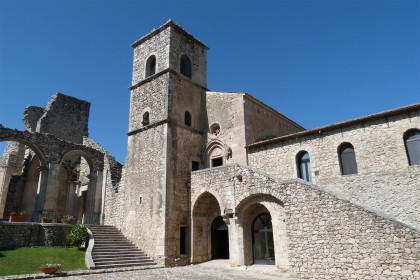St. William of Vercelli, consecrated monaco year 1100, was a pilgrim and hermit. He arrived in the plain of Goleto in 1131, where he immediately began the construction of the Abbey after founding the Congregation Verginiana on Mount feverfew. Some experts considered ‘double monastery’ for the simultaneous presence of nuns and monks, was right in its most flourishing age from abbess until 1506, when the female monastery was suppressed by Pope Julius II. Since then the monks were to lead forward the life of the Abbey. With the suppression of religious orders in 1807, the monastery fell into disrepair: the Saint’s body was moved to Montevergine, furnishings major transferred to Sant’Angelo or brought in Nusco and Lioni, leaving all’incuria Time and the robbery of ‘man the sacred stones of the building. Only in 1973 he tried to recover the site thanks to the intervention of Father Lucio De Marino, but the violent earthquake of 1980 wreaked massive new damage to the already crumbling structures. A targeted work of reconstruction and restoration returns today part of the splendor of the place, inhabited by the monks of the family of ” Charles de Foucauld ”. Among the most interesting elements emerge architectural structure that houses the two superimposed chapels: the upper one, dating back to the thirteenth century, it is called San Luca because sorts to house a relic of the saint. The church is divided into two aisles, defined by two central columns and ten semi-lateral, governing pointed vaults; beautiful frescoes survivors, who retain some scenes of St. William and two medallions depicting abbesses School and Marina. The elements of the upper chapel Frederick diverge Apulian architecture of the twelfth century that seems to contaminate the style of the lower church, which nevertheless retains the outline of the church of San Luca. Febronia Tower is so named in honor of the abbess who ordered its construction in the twelfth century. The tower is made of hewn stone of an existing funeral monument of the Roman consul Marco Paccio Marcello, and you can still admire the friezes and bas-reliefs of the first century AD The purpose of the building was clearly defensive, similar to that of the keep in the castles. Of great historical and artistic value is also the remains of the church of Vaccaro, whose construction began in 1735. The plant was a Greek cross and the building topped by a large dome; the walls were presented adorned with stucco and the beautiful staircase access is now rebuilt by the new model of other stairways vaccariane. The Abbey of Goleto is undoubtedly one of the most beautiful places of the south of the peninsula, and today is a place of pilgrimage ever more appreciated and frequented.

 Add to favorites
Add to favorites
